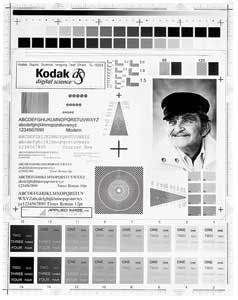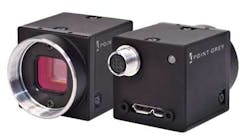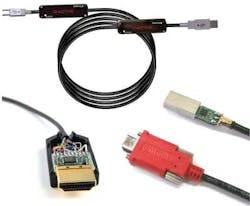PRODUCT FOCUS - Looking to the Future of Vision
Andrew Wilson, Editor
"You can't just ask customers what they want and then try to give that to them. By the time you get it built, they'll want something new." I quote from the late Steve Jobs who, as co-founder of Apple Computer, took a different approach to product design. While he was intimately involved with co-founding the company, his rather—dare I say radical and somewhat arrogant approach—brought fame and fortune to himself and his shareholders.
Those involved in the machine-vision and image-processing industry have also produced innovative products. However, despite the innovations in CMOS and CCD devices, smart cameras, cables interfaces, processors, lighting, standards and display technologies, much remains to be accomplished. In future, emerging technologies will allow OEM suppliers to create niche products targeted at specific applications and supply more sophisticated systems that reduce the cost and time of system integration.
Test charts
In every area of machine vision opportunity exists, and many innovations are being pioneered by developers needing to solve specific problems. For example, a number of test charts are currently available from companies such as Edmund Optics for area-array camera calibration (see Fig. 1). However, very few of these targets have been specifically developed for linescan camera calibration.
Recognizing this, PVI Systems developed its own target specifically designed for the task (see "Custom Calibration Supports Linescan System Design," Vision Systems Design, December 2011). Similarly, there are very few test targets or test objects readily available as standard products to calibrate the measurement of 3-D objects such as bottles. This has forced many companies, including Mettler-Toledo CI-Vision, to develop a high-precision 3-D metal target for the calibration of a bottle inspection system.
These test targets are not yet available as standard products, but making such products and the software used to calibrate the machine-vision systems based around them would save other system developers time and money. The need to understand and test each product used in a machine-vision system is one of the main problems facing system integrators.
As Greg Hollows, director of machine vision solutions at Edmund Optics, points out, specifying system performance has always been critical to success in machine vision and imaging (see "Into the Depths," Vision Systems Design, September 2011).
Standards adoption
For the developer, specifying this system performance is not an easy task. Characterization of image sensors and cameras in terms of parameters such as linearity, sensitivity, and noise can be accomplished using standards like EMVA 1288. A number of companies including Sarnoff, Aphesa, Aeon Verlag and Studio, and Image Engineering already manufacture test equipment to perform these tests.
Despite this support, many linescan and area-scan image sensor and camera companies have yet to embrace this standard. Unfortunately, the lack of standards adoption is also rife in the optics industry. Some companies even tout their lenses as "5 Mpixel," leading the unknowing developer to believe such lenses will resolve the smallest line-pair pixel spacing of the image sensor.
Since many of these manufacturers—especially those with low-cost products—conveniently forget to produce MTF charts with their lenses, it is impossible for the potential purchaser to comprehend the resolving power of the lens.
Lens/camera performance is of vital importance to any vision system, and it can be further complicated if filters are used. As Stuart Singer, vice president of Schneider Optics, notes, the use of such filters can often significantly alter the final image quality of the optical systems (see "Filters Factor into Optical Imaging," Vision Systems Design, October 2011).
Here again, data about the optical quality of filters are rarely provided by manufacturers, placing an additional burden on the system developer. Hopefully, in future, savvy customers demanding sensor, camera, and optics standards will allow products to be more easily compared while simultaneously reducing the system integration time required.
Camera interfaces
For system integrators looking to interface cameras to computers, there is also an abundance of standards ranging from slow analog broadcast standards such as RS-170 to very high-speed point-to-point digital interfaces such as the Camera Link HS standard.
Although it remains to be seen whether Intel's bidirectional, 10-Gbit/s Thunderbolt interface will be readily adopted by those in the machine-vision industry, other recently announced PC-based standards such as USB 3.0 have already been adopted by camera vendors such as Point Grey Research.
At November's VISION show in Stuttgart, for example, the company showed the first of its USB 3.0 products, the FL3-U3-32S2—a 3.2-Mpixel CMOS-based camera that operates at 60 frames/s (see Fig. 2).
For those in the machine-vision industry, however, USB may not be fully accepted until next year when the Automated Imaging Association (AIA) releases a final version of USB3 Vision, a standard that will offer power and data over one passive cable up to 5 m long at a bandwidth of 3.2 Gbits/s.
Committee members involved in developing this standard number more than 10 camera companies (see "AIA targets USB3 camera interface standard for 2012 release"). When ratified, it is likely that USB3 Vision will replace the IEEE 1394 (FireWire) standard in machine-vision applications.
Like USB 3.0, the network-based GigE Vision protocol will also be more widely adopted after the introduction of Version 2.0 of the standard. According to Vincent Rowley, a systems architect at Pleora Technologies and vice-chair of the GigE Vision Committee, the revised standard supports a number of notable features including support for interlaced video, improved transmission latency for multitap sensors, and a new pixel-format naming convention.
The new technical specification was approved by the GigE Vision Committee in October 2011 and is expected to be released this month (see the January 2012 issue of Vision Systems Design magazine for a complete description).
For high-performance point-to-point data transfer between cameras and computers, the Camera Link interface standard has gained the most support among camera and frame grabber vendors. In its full configuration, 64-bit-wide data can be transferred at 5.44 Gbits/s (680 Mbytes/s), although some camera and frame grabber vendors such as Basler extended the bandwidth of the interface by redefining pins to produce a data-path width of up to 80 bits over two connectors/cables, thus increasing the bandwidth to 6.8 Gbits/s (see "Beyond Camera Link," Vision Systems Design, October 2007).
Higher speeds
With the introduction of numerous high-speed CMOS linescan and area-array cameras, camera and frame grabber vendors realized the need to develop faster camera interfaces. This has resulted in the creation of two such standards: Camera Link HS, which supports a range of data transfer speeds from 300 Mbytes/s to 6 Gbytes/s; and CoaXPress, which operates at up to 6.25 Gbits/s using a single 75-Ω coaxial cable. For faster data transfer rates, CoaXPress supports multiple cable configurations that can be used to allow speeds of 25 Gbits/s and beyond. Camera Link HS supports cable lengths up to 15 m; CoaXPress allows camera-to-computer connections at distances up to 100 m.
CoaXPress and Camera Link HS differ radically in their designs, with the former being more of a hardware-only implementation while the latter requires a hardware and software (IP) approach. It is likely that in future many camera and frame grabber vendors that do not yet support either standard may opt to implement CoaXPress designs before attempting Camera Link HS implementations.
In the past, system integrators looking for camera-to-computer cables for these types of standards had used passive cables that transfer data over limited distances. To support higher-speed standards such as Intel's Thunderbolt, USB 3.0, and HDMI, cable vendors have developed numerous active cable products that incorporate driver/equalizer chipsets often in the cable connectors themselves (see "Active Cables Lengthen Camera-to-Computer Connectivity," Vision Systems Design, September 2011).
Though active cables extend camera-to-computer interface distances dramatically, it is interesting that many cable manufacturers who target the machine-vision market have yet to introduce such products, leaving developments to those cable companies most commonly associated with the consumer market (see Fig. 3). It is more than likely that within the next few years many cable companies will need to introduce active cables to remain competitive.
Software standards
Standardized computer interfaces allow system developers to incorporate products from a number of different camera vendors. The popular GenICam standard has allowed camera vendors to offer a generic programming interface for their cameras, independent of which computer interface is used. Adopted by more than 100 camera and software suppliers, GenICam allows developers to access and modify camera parameters through a unified interface, saving time and money.
While these interface standards are valuable, no such standard exists to allow developers to benchmark the performance of third-party software. Despite proposals from MVTec Software to develop benchmarks (see "Toward a Machine-Vision Benchmark," Vision Systems Design, May 2009), software vendors have been reluctant to adopt any such idea.
Renewed interest in a software benchmark has led a group headed by VIALAB to pursue a benchmark of commercial machine-vision software libraries (see "Project seeks to institute a benchmark for machine vision"). At the VISION 2011 tradeshow in Stuttgart (see "VISION 2011 plans to bring together machine vision system integrators and end users"), the researchers discussed the principles, procedures, and ultimate goals of the software benchmark they plan to create (see "Setting the Standard," Vision Systems Design, November 2008). They also shared the insights they gained defining a prototype benchmark, and discussed plans concerning the next stages of the project.
The acceptance of numerous vision standards have led to a broader range of product offerings and reduced product prices. Lowering the cost of vision products has resulted in their use in a number of nonindustrial applications, such as intelligent transportation and embedded medical imaging systems. On the other hand, the lack of adoption of some of these standards by vendors has placed a burden on system integrators wishing to compare products. Hopefully, in future, such standards will become more widely adopted, making comparisons a lot easier.
Company Info
Aeon Verlag and Studio, Hanau, Germany
AphesaHarzé, Belgium
Automated Imaging Association, Ann Arbor, MI, USA
Edmund Optics, Barrington, NJ, USA
Image Engineering, Frechen, Germany
Mettler-Toledo CI-Vision, Aurora, IL, USA
MVTec Software, Munich, Germany
Pleora Technologies, Kanata, ON, Canada
Point Grey Research, Richmond, BC, Canada
PVI Systems, Niantic, CT, USA
Sarnoff, Princeton, NJ, USA
Schneider Optics, Hauppauge, NY, USA
Vialab, Bologna, Italy




